Gastric Cancer Diagnostic Market Research, 2032
The global gastric cancer diagnostic market size was valued at $2.3 billion in 2022, and is projected to reach $3.8 billion by 2032, growing at a CAGR of 5.3% from 2023 to 2032. The growth of the gastric cancer diagnostic market is driven by a rise in incidences of gastric cancer around the globe and surge in demand for advanced gastric cancer diagnostic for the treatment of these infections. For instance, according to the American Cancer Society, the stomach cancer accounted for about 1.5% of all new cancers diagnosed in the U.S. each year. In addition, according to the Centre for Health Protection, around 1,197 new cases of stomach cancer diagnosed in 2020, with 715 cases of males and 482 cases of female. The rise in incidence of gastric cancer has increased the demand for gastric cancer diagnostic tools which propels the market growth.
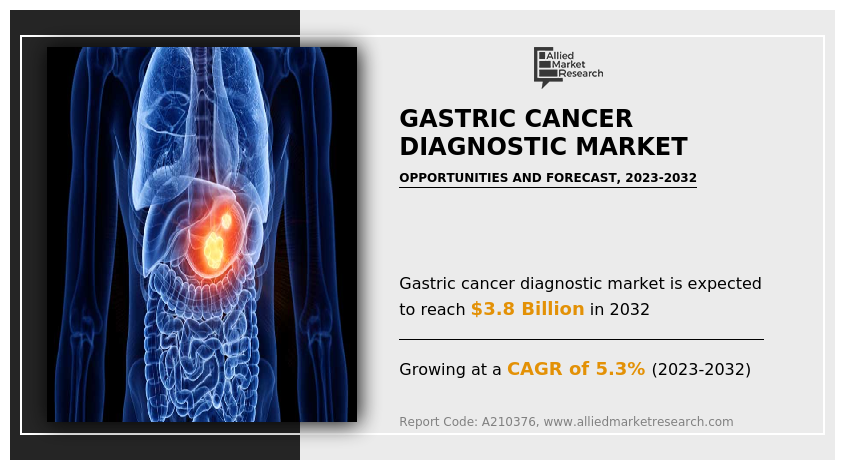
Key Takeaways
- The reagents & consumables segment dominated the global market in 2022. However, the instruments segment is expected to register the highest CAGR during the forecast period.
- The adenocarcinoma segment dominated the global market in 2022 and is anticipated to be the fastest-growing segment during the forecast period.
- The diagnostic laboratories segment dominated the market in terms of revenue in 2022.
- The North America region dominated the market in terms of revenue in 2022. However, Asia-Pacific is anticipated to grow at the highest CAGR during the forecast period.
Gastric cancer diagnostic is an identifying and confirming the presence of gastric cancer, which is also known as stomach cancer. It encompasses a range of medical procedures, tests, and evaluations performed by healthcare professionals to determine if a patient has developed cancer in the stomach. These diagnostic methods may include imaging studies, endoscopic examinations, biopsy, blood tests, and molecular profiling. The goal of gastric cancer diagnostics is to detect the disease at an early stage, accurately assess its extent and severity, and guide treatment decisions. Early diagnosis is crucial as it may significantly impact patient outcomes by allowing for timely intervention and appropriate treatment.
Market Dynamics
The surge in prevalence of gastric cancer globally creates a growing demand for diagnostic services, as more cases are detected, the demand for diagnostic tools and methods rises which drives the market growth. In addition, ongoing technological advancements, such as improved endoscopy, molecular testing, and imaging techniques, enhance the accuracy and efficiency of gastric cancer diagnosis which is expected to drive the market growth. Advanced endoscopic technologies, such as high-definition and magnifying endoscopy, enable healthcare providers to visualize the gastric mucosa with exceptional clarity and detail. This heightened precision allows for the early detection of subtle abnormalities and precancerous lesions which further support the market growth.
Gastric cancer is more common in older individuals. The geriatric population is more prone to cancer disease which results in increased demand for diagnostic testing such as gastric cancer diagnostic which contributes towards the market growth. For instance, an article published by the Journal of Gastric Cancer, in 2022, gastric cancer occurs in older patients, with most patients being 60 or higher, and the proportion of gastric cancer patients over 70 years old is increasing. This increasing trend has resulted in an increase in elderly patients requiring radical gastrectomy which propels gastric cancer diagnostic industry growth.
However, the high cost of diagnostic tests may deter individuals from seeking early diagnosis, particularly in regions with limited access to affordable healthcare which negatively impacted the market growth. Patients may postpone or avoid diagnostic tests due to concerns about the financial burden, which may lead to delayed diagnosis and, in turn, more advanced stages of the disease at the time of diagnosis and restrain the market growth.
On the other hand, growing awareness about the importance of early diagnosis and the availability of gastric cancer diagnostic has become a driving force in improving public health and cancer care. This increased awareness is helping individuals understand the significance of early detection in the fight against gastric cancer, a disease that can often remain asymptomatic until it reaches advanced stages which fuels the gastric cancer diagnostic market growth.
In addition, awareness campaigns are educating the public about the risk factors associated with gastric cancer, which include factors such as age, family history, certain dietary habits, and Helicobacter pylori infection. By understanding these risk factors, individuals are more likely to recognize when they may be at higher risk and therefore take proactive steps to undergo screening and diagnostic tests which provide gastric cancer diagnostic market opportunity.
The ongoing global economic recession influences several industries, including biotechnology and pharmaceuticals, which has an impact on the development and demand for gastric cancer diagnostics. During economic downturns, individuals and governments may cut back on healthcare spending. This can lead to reduced funding for healthcare facilities, diagnostic services, and research initiatives, which could negatively impact the gastric cancer diagnostic market. In addition, economic recessions often lead to reduced R&D funding from both the public and private sectors. This could slow down the development of innovative diagnostic tools and techniques.
Despite these challenges, the gastric cancer diagnostic market continues to experience moderate revenue growth due to the ongoing need for diagnostic testing in healthcare. The demand for gastric cancer diagnostic has remained comparatively consistent throughout the recession as the market participants are adjusting manufacturing capabilities and concentrating on the usage of current inventory.
Segmental Overview
The gastric cancer diagnostic market size is segmented on the basis of product, disease type, end user, and region. By product, the market is classified into reagents & consumables, and instruments. By disease type, the market is segmented into adenocarcinoma, gastric lymphoma, and others. By end user, the market is segmented into hospitals, diagnostic laboratories, and diagnostic imaging centers. Region-wise, the market is analyzed across North America (the U.S., Canada, and Mexico), Europe (Germany, France, the UK, Italy, Spain, and rest of Europe), Asia-Pacific (China, Japan, Australia, India, South Korea, and rest of Asia-Pacific), and LAMEA (Brazil, South Africa, Saudi Arabia, and rest of LAMEA).
By Product
The reagents & consumables segment dominated the market share in 2022. This is attributed to the rise in incidence of gastric cancer, advancements in diagnostic technologies, and the increase in focus on personalized medicine in cancer care.
On the other hand, the instruments segment is anticipated to be the fastest growing segment during the gastric cancer diagnostic market forecast period. This growth is due to rise in technological advancements, early detection capabilities, the adoption of precision medicine, increasing healthcare investment, and rise in gastric cancer incidence.
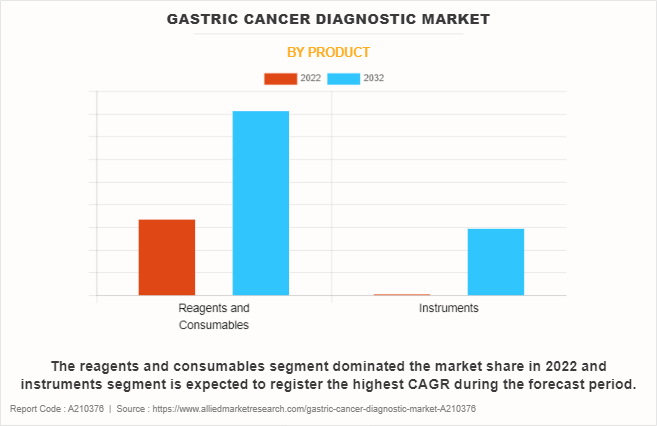
By Disease Type
The adenocarcinoma segment dominated the gastric cancer diagnostic market share in 2022 and is anticipated to be the fastest growing segment during the forecast period. Adenocarcinoma is the most common type of gastric cancer, accounting for a significant proportion of all gastric cancer cases. Its high incidence contributes to its dominance in the market.
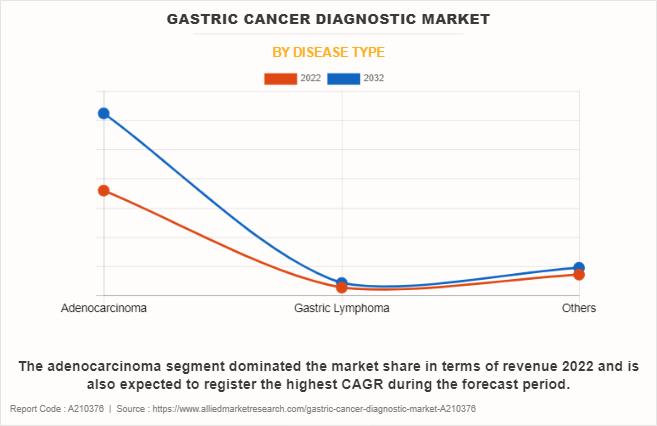
By End User
The diagnostic laboratories segment dominated the gastric cancer diagnostic market share in terms of revenue in 2022 and is anticipated to be the fastest growing segment during the forecast period. The growth of the segment is attributed to the presence of advanced diagnostic facilities and expertise, and the ability to provide a wide range of services, from diagnosis to treatment and follow-up care.
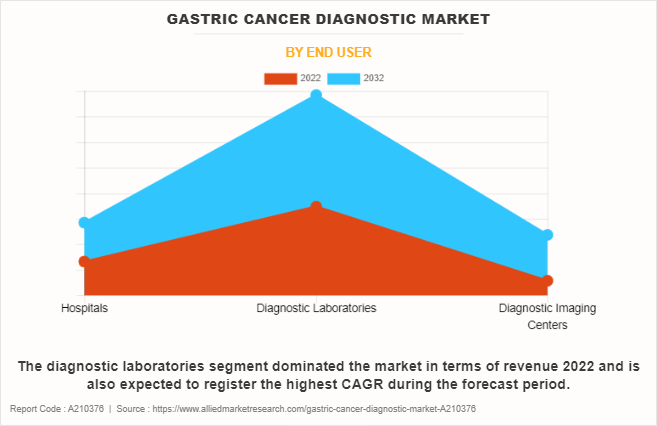
By Region
The gastric cancer diagnostic industry is analyzed across North America, Europe, Asia-Pacific, and LAMEA. North America region dominated the market in terms of revenue in 2022. The growth in this region is attributed to the advanced healthcare infrastructure, higher incidence rates, rise in screening programs, a focus on precision medicine, and growing aging population. In addition, the presence of several major players, such as Abbott Laboratories, F. Hoffmann-La Roche Ltd, Bio-Rad Laboratories, Inc., and Agilent Technologies, Inc. contributes to the market growth in the region.
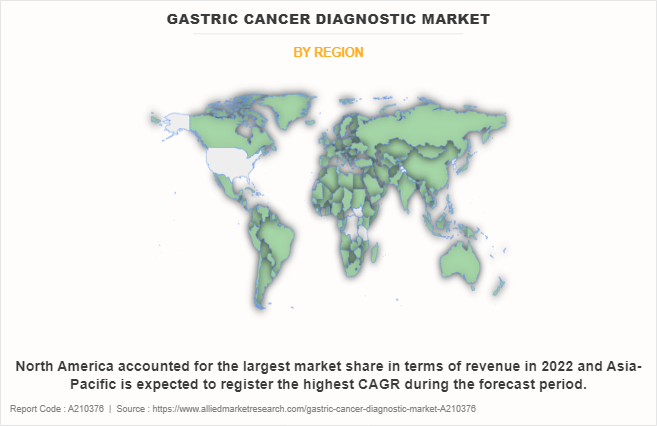
Asia-Pacific is expected to grow at the highest rate during the forecast period. This is attributed to high incidence of gastric cancer, a large and diverse population, improving healthcare infrastructure, rise in government initiatives, an aging population, rise in technological advancements in diagnostics. In addition, the rise in research and clinical trials, growing awareness, pharmaceutical and biotechnology investments, and economic growth are the factors that drive the market growth in this region.
Asia-Pacific offers profitable opportunities for key players operating in the gastric cancer diagnostic market, thereby registering the fastest growth rate during the forecast period, owing to the growing infrastructure of industries and rise in adoption of the advanced medical technologies. In addition, growing awareness about the benefits of timely medical intervention and the importance of early diagnosis and treatment have driven the demand for gastric cancer diagnostic and propel the market growth.
Competition Analysis
Competitive analysis and profiles of the major players in the gastric cancer diagnostic market, such as Bio-Rad Laboratories, Inc., Qiagen NV., Agilent Technologies, Inc., Exact Sciences Corporation, MiRXES Pte Ltd, Hipro Biotechnology Co.,Ltd., Fulgent Genetics, Endofotonics Pte Ltd, Abbott Laboratories, and F. Hoffmann-La Roche Ltd. Major players have adopted product approval, partnership, and agreement as a key developmental strategies to improve the product portfolio and gain a strong foothold in the gastric cancer diagnostic market.
Recent Product Approvals in the Gastric Cancer Diagnostic Market
- In August 2023 QIAGEN announced that it has received the U.S. Food and Drug Administration (FDA) approval for its therascreen PDGFRA RGQ PCR kit (therascreen PDGFRA kit).
- In October 2021, Agilent Technologies Inc. announced it has received CE-IVD mark approval for the PD-L1 IHC 28-8 pharmDx to guide options for the first-line treatment of adult patients with HER2-negative advanced or metastatic gastric, gastroesophageal junction, or esophageal cancers.
- In August 2023, Mirxes Corporation USA, the wholly owned subsidiary of Mirxes Pte Ltd announced that its flagship product GASTROClearTM, a PCR-based in vitro diagnostic test for early detection of gastric (stomach) cancer, has been granted Breakthrough Device Designation by the U.S. Food and Drug Administration (FDA).
Recent Agreement in the Gastric Cancer Diagnostic Market
- In August 2022, Bio-Rad Laboratories, Inc., a global leader in life science research and clinical diagnostic products announced that it has reached an agreement to acquire all of the outstanding shares of Curiosity Diagnostics, Sp. Z. o. o. from Scope Fluidics, S.A., a Warsaw, Poland, based developer of innovative technology solutions for the medical diagnostic and healthcare markets.
Recent Partnership in the Gastric Cancer Diagnostic Market
- In January 2023, Agilent Technologies, Inc. announced a partnership with Akoya Biosciences, Inc., to develop multiplex-immunohistochemistry diagnostic solutions for tissue analysis and to commercialize workflow solutions for multiplex assays in the clinical research market. Integrating Agilent’s Dako Omnis (autostaining instrument) and Akoya’s PhenoImager HT (imaging platform) for multiplex chromogenic immunohistochemistry (mIHC) and immunofluorescent (mIF) assays are expected to create a singular end-to-end commercial workflow, including reagents, staining, imaging, and analysis.
Key Benefits For Stakeholders
- This report provides a quantitative analysis of the market segments, current trends, estimations, and dynamics of the gastric cancer diagnostic market analysis from 2022 to 2032 to identify the prevailing gastric cancer diagnostic market opportunities.
- The market research is offered along with information related to key drivers, restraints, and opportunities.
- Porter's five forces analysis highlights the potency of buyers and suppliers to enable stakeholders make profit-oriented business decisions and strengthen their supplier-buyer network.
- In-depth analysis of the gastric cancer diagnostic market segmentation assists to determine the prevailing market opportunities.
- Major countries in each region are mapped according to their revenue contribution to the global market.
- Market player positioning facilitates benchmarking and provides a clear understanding of the present position of the market players.
- The report includes the analysis of the regional as well as global gastric cancer diagnostic market trends, key players, market segments, application areas, and market growth strategies.
Gastric Cancer Diagnostic Market Report Highlights
| Aspects | Details |
| Market Size By 2032 | USD 3.8 billion |
| Growth Rate | CAGR of 5.3% |
| Forecast period | 2022 - 2032 |
| Report Pages | 260 |
| By Product |
|
| By Disease Type |
|
| By End User |
|
| By Region |
|
| Key Market Players | Agilent Technologies, Inc., Fulgent Genetics, Endofotonics Pte Ltd, Hipro Biotechnology Co.,Ltd., Abbott Laboratories, F. Hoffmann-La Roche Ltd., Bio-Rad Laboratories, Inc. , Exact Sciences Corporation, MiRXES Pte Ltd, Qiagen NV. |
Analyst Review
This section provides various opinions of top-level in the gastric cancer diagnostic market. An increase in demand for gastric cancer diagnostic and rise in awareness about the importance of early diagnosis & treatment are expected to offer profitable opportunities for the expansion of the market. However, the high cost of diagnostic tests hinders the market growth.
In addition, surge in the prevalence of gastric cancer and a rise in awareness regarding the potential benefits of advanced gastric cancer diagnostic have led to an increase in demand for gastric cancer diagnostic across the globe, which is expected to fuel market growth during the forecast period. In addition, surge in demand for early disease diagnosis, rise in geriatric population, and increase in healthcare expenditure drive the growth of the market.
Furthermore, North America dominated the market share in terms of revenue, owing to a rise in prevalence of gastric cancer, increase in diagnostic tests, and easy availability of gastric cancer diagnostic products. However, Asia-Pacific is expected to register the highest CAGR during the forecast period, owing to rise in technological advancement, development of healthcare settings, and surge in prevalence of gastric cancer.
The total market value of gastric cancer diagnostic market is $2.3 billion in 2022.
The market value of gastric cancer diagnostic market in 2032 is $3.8 billion.
The forecast period for gastric cancer diagnostic market is 2023 to 2032.
The base year is 2022 in gastric cancer diagnostic market.
F. Hoffmann-La Roche Ltd., Agilent Technologies, Inc., Exact Sciences Corporation, Qiagen NV., and Abbott Laboratories held a high market position in 2022.
The growth of the gastric cancer diagnostic market is primarily driven by rise in prevalence of gastric cancer, advances in diagnostic technologies, and the growing awareness of the importance of early detection.
The reagents and consumables segment is the most influencing segment in gastric cancer diagnostic market owing to increase in adoption of molecular testing in the diagnosis of gastric cancer, which has driven the demand for specific reagents designed for detecting genetic mutations, biomarkers, and other molecular indicators associated with the disease.
Gastric cancer, also known as stomach cancer, is a malignancy that develops in the cells lining the inner surface of the stomach.
Loading Table Of Content...
Loading Research Methodology...



